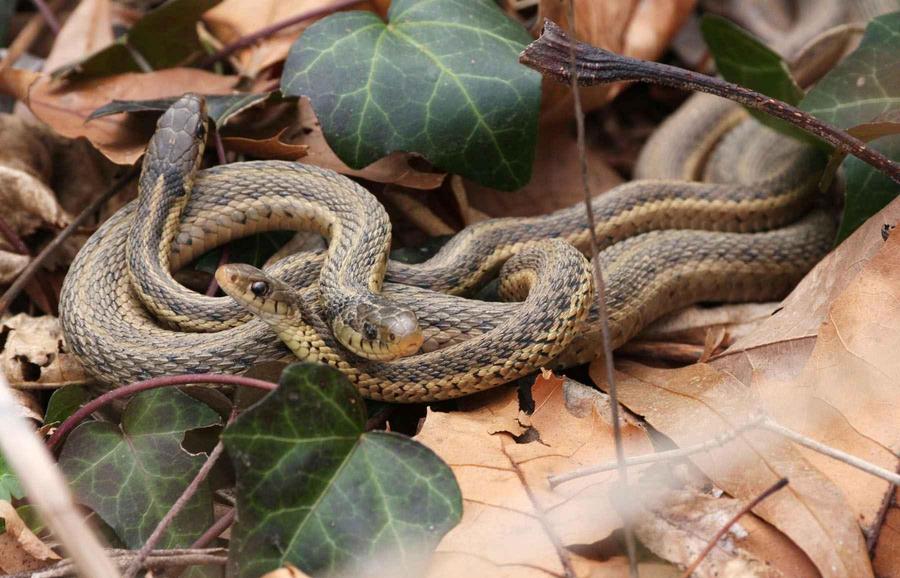Bob Suchanek, Water and Wetlands Steward

The Common Garter Snake, Thamnophis sirtalis. Public Domain Photo by Miles Frank, USFWS
https://pixnio.com/fauna-animals/reptiles-and-amphibians/snakes-pictures/garter-snakes/garter-snakes-reptiles-thamnophis-sirtalis#
The common garter snake slithers farther north than any other snake in North America. Hardy and adaptable, this reptile is found nearly everywhere in the continental US and Canada, with only the icy polar regions of northern Canada and hottest, driest deserts of the American southwest limiting their range. Garter snakes inhabit every single county in Minnesota.
Snakes of all stripes are descended from burrowing lizards that lived at the feet of giants during the “age of dinosaurs”. The warm dinosaur world was an ideal habitat for snake ancestors. Since snakes are ectotherms (ecto - outside, therm - heat), their internal body temperature closely reflects the temperature of their environment. The warm Mesozoic world allowed them to reach their slithering activity peak every day beneath sauropods and raptors.
One day about 65 million years ago the world that gave rise to both snakes and dinosaurs changed to a survival nightmare. A huge asteroid or comet hit the earth, set much of it ablaze, and exterminated 75% of animal life. The ecological chaos of that celestial impact left a world without giants but full of opportunity for small burrowing ectotherms.
It's difficult for me, a “warm blooded” endothermic (inside heat) to appreciate how the “cold blooded” lifestyle is suited to Minnesota winters. After a hearty breakfast of pancakes and maple syrup I'm fired up and ready to go no matter the outside temperature. Snakes, on the other hand, prefer a warming bask in the sun before breakfast. They're energy minimalists, reducing their need for food through less dependence on internally produced heat. Their bodies cool when external heat is unavailable and they become inactive. This ability to literally chill is a huge survival advantage during tough times. In order to ensure survival during the winter, garter snakes congregate in sheltering holes and enter a state of inactivity called brumation. These sheltering holes (hibernacula) are below the frost line, next to building foundations or anywhere the cold is moderated. Groupings may exceed 1,000 snakes and congregations of around 8,000 snakes have been noted in Canadian limestone sinkholes.
In addition to the survival advantages of ectothermy, snakes reproduce rapidly. Most snakes lay eggs, sometimes dozens at a time. Although most baby snakes don't survive, their large numbers help insure population replacement and often population growth. The common garter snake mom goes a step beyond egg laying and improves the survival of her clutch by retaining the eggs in her body until they hatch. She gives birth to fully formed baby snakes.
Why (and what is) a Garter?
The only snake I saw as a child was the common garter snake. I was sure my mother called it a “garter” snake, not a “gardener” snake (even though “gardener” made more sense as I saw them there sometimes). What did “garter” mean? Being told that a garter is a strip of fabric that holds up a stocking didn't really help, my socks held themselves up. Well it turns out that someone in the 18th century thought the stripes of the common garter snake made it look like the design on their stocking holder and the name stuck, hence the biologist's Thamnophis sirtalis (Thamnophis, bush serpent; sirtalis, like a garter).
Some sources:
Amphibians and Reptiles in Minnesota. J. J. Moriarty and C. D. Hall. 2014. University of Minnesota Press.
https://www.dnr.state.mn.us/livingwith_wildlife/snakes/index.html
https://www.dnr.state.mn.us/reptiles_amphibians/index.html
https://www.labroots.com/trending/genetics-and-genomics/21396/mass-extinction-modern-snakes-evolved-survivors
https://birdwatchinghq.com/garter-snakes-in-canada/
https://www.climate-policy-watcher.org/global-climate-2/cretaceous-era.html
http://www.gartersnake.info/articles/2008/garter-snakes-in-winter.php
https://www.lllreptile.com/articles/126-reptilian-brumation/